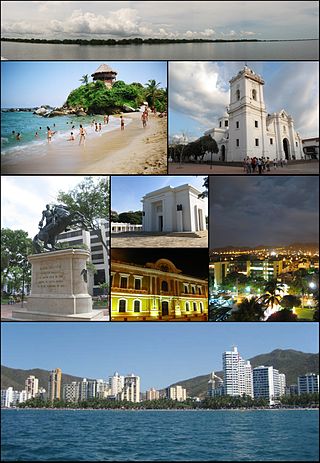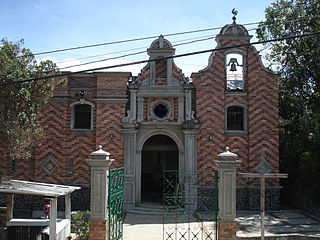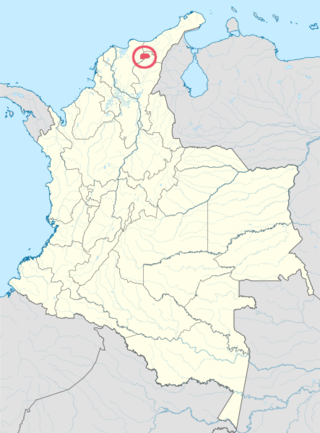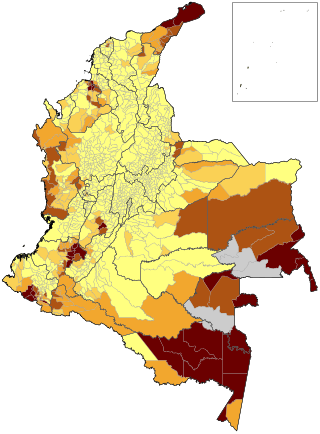
Santa Marta, officially the Distrito Turístico, Cultural e Histórico de Santa Marta, is a city on the coast of the Caribbean Sea in northern Colombia. It is the capital of Magdalena Department and the fourth-largest urban city of the Caribbean Region of Colombia, after Barranquilla, Cartagena, and Soledad. Founded on July 29, 1525, by the Spanish conqueror Rodrigo de Bastidas, it was one of the first Spanish settlements in Colombia, its oldest surviving city, and second oldest in South America. This city is situated on a bay by the same name and as such, it is a prime tourist destination in the Caribbean region.

Valledupar is a city and municipality in northeastern Colombia. It is the capital of Caesar Department. Its name, Valle de Upar, was established in honor of the Amerindian cacique who ruled the valley; Cacique Upar. The city lies between the mountains of St. Martha Snow Mountain Range and the Periha Mountain Range to the borders of the Guatapuri and Caesar rivers.

Ciudad Perdida is the archaeological site of an ancient city in the Sierra Nevada de Santa Marta of Colombia, within the jurisdiction of the city of Santa Marta. This city is believed to have been founded about 800 CE. If so, Ciudad Perdida predates Machu Picchu by about 650 years.

Gerardo Reichel-Dolmatoff was an Austrian anthropologist and archaeologist. He is known for his fieldwork among many different Amerindian cultures such as in the Amazonian tropical rainforests, and also among dozens of other indigenous groups in Colombia in the Caribbean Coast, as well as others living in the Pacific Coast, Llanos Orientales, and in the Andean and inter-Andean regions (Muisca) as well as in other areas of Colombia, and he also did research on campesino societies. For nearly six decades he advanced ethnographic and anthropological studies, as well as archeological research, and as a scholar was a prolific writer and public figure renowned as a staunch defender of indigenous peoples. Reichel-Dolmatoff has worked with other archaeologists and anthropologists such as Marianne Cardale de Schrimpff, Ana María Groot, Gonzalo Correal Urrego and others. He died 17 May 1994 in Colombia.

The Sierra Nevada de Santa Marta is an isolated mountain range in northern Colombia, separate from the Andes range that runs through the north of the country. Reaching an elevation of 5,700 m (18,700 ft) just 42 km (26 mi) from the Caribbean coast, the Sierra Nevada is the highest coastal range in the tropics, and one of the highest coastal ranges in the world, being 250 metres (820 ft) shorter than the Saint Elias Mountains in Canada. The Sierra Nevada encompasses about 17,000 km2 (6,600 sq mi) and serves as the source of 36 rivers. The range is in the Departments of Magdalena, Cesar and La Guajira.

Indigenous peoples of Colombia, are the ethnic groups who have inhabited Colombia since before the European colonization, in the early 16th century. According to the last census, they comprise 4.4% of the country's population, belonging to 115 different tribes.

The Arhuaco are an indigenous people of Colombia. They are Chibchan-speaking people and descendants of the Tairona culture, concentrated in northern Colombia in the Sierra Nevada de Santa Marta.

The Kogi, or Cogui, or Kágaba, meaning "jaguar" in the Kogi language, are an indigenous group that resides in the Sierra Nevada de Santa Marta mountains in northern Colombia. Their culture has continued since the Pre-Columbian era.

Pueblo Bello, is a village and municipality in the northern region of the Department of Cesar, Colombia. It is located in the mountains of the Sierra Nevada de Santa Marta and is home to Amerindians pertaining to the Arhuaco ethnicity, whom consider Pueblo Bello a sanctuary but by the name of Arumake in their language. Pueblo Bello is the main producer of coffee in the Caribbean Region of Colombia.

La Guajira is a department of Colombia. It occupies most of the Guajira Peninsula in the northeast region of the country, on the Caribbean Sea and bordering Venezuela, at the northernmost tip of South America. The capital city of the department is Riohacha.

Dibulla is a town and municipality located in the Department of La Guajira, Colombia by the Caribbean sea and the Sierra Nevada de Santa Marta mountains on the Guajira Peninsula. It was proclaimed municipality in 1995.

The Spanish conquest of the Chibchan nations refers to the conquest by the Spanish monarchy of the Chibcha language-speaking nations, mainly the Muisca and Tairona that inhabited present-day Colombia, beginning the Spanish colonization of the Americas.
Art of Cesar Department refers to the expressions of art in the Colombian Department of Cesar in the Caribbean Region of Colombia. The diverse range of human activities and artifacts, painting, sculpture, printmaking, musical and dance expressions, literature and other forms of visual and auditory arts.

The Architecture of Cesar Department refers to the architecture in the Cesar Department of Colombia, which still preserves much of the colonial architecture inherited by the Spanish colonization and the architecture developed by the numerous tribes of indigenous peoples of the Cesar Department that included the Tairona, Chimila, Motilon and Kalina.

Atanquez or San Sebastian is a Colombian town and corregimiento of Valledupar in the Department of Cesar. Atanquez is located on the Sierra Nevada de Santa Marta mountain range at approximately 2,000 m over sea level. Atanquez is known for being predominantly inhabited by the indigenous ethnic group Kankuamos among others and mestizo groups.

Arhuaco, commonly known as Ikʉ, is an Indigenous American language of the Chibchan language family, spoken in South America by the Arhuaco people.
Atanque, also known as Atanques or Kankuamo, is an extinct Chibchan language of Colombia, once spoken in the area of Sierra Nevada de Santa Marta.

The Kankuamo, Kankuaka, Kankui or Kankuané are an indigenous people of Colombia, living on the southern slopes of the Sierra Nevada de Santa Marta up until the north of the César department. The Kankuamo people, estimated at around 15,000 individuals, speak Sánha, a dialect of the Atanque language of the Chibcha family. Their laws are borne from nature and they consider the Sierra Nevada de Santa Marta, the highest mountain range closest to the sea, as sacred. In their native tongue they call this Umunukunu. Many Kankuamo, mostly merchants, do not speak their native language.

The first presidential inauguration of Juan Manuel Santos marked the first term of the presidency of Juan Manuel Santos, an administration that would later be postponed for four more years. The ceremony was attended by 3,000 guests including several heads of state and government of the world.
The second inauguration of Juan Manuel Santos as the 32rd President of Colombia marked the beginning of his second term in the house of Nariño as head of state for Juan Manuel Santos, being the fifth president of Colombia to be re-elected and the second in a row, for this time his vice-presidential formula fell to the former interior minister and former finance minister Germán Vargas Lleras, who was sworn in as the 10th Vice President.






















